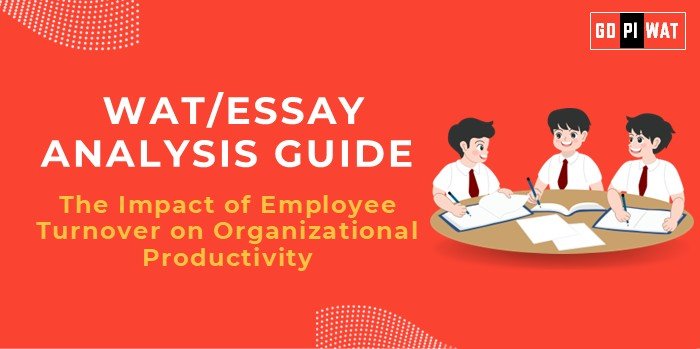📋 Written Ability Test (WAT)/Essay Analysis Guide
Topic: The Impact of Employee Turnover on Organizational Productivity
🌟 Understanding the Topic’s Importance
Employee turnover is a critical factor influencing organizational performance, touching upon core areas like leadership, operations, and human resource management. B-schools focus on this topic to evaluate analytical skills and the ability to propose actionable strategies.
⏱️ Effective Planning and Writing
- Time Allocation (30 minutes):
- 📝 Planning: 5 minutes to outline key points and structure.
- ✍️ Writing: 20 minutes to develop arguments and conclusions.
- 🔍 Review: 5 minutes for editing and polishing.
- Preparation Tips:
- Prioritize recent statistics and relevant case studies.
- Consider stakeholder roles and their interplay in mitigating turnover’s effects.
💡 Introduction Techniques for Essays
- Contrast Approach:
“While turnover introduces fresh talent and ideas, its frequent occurrence drains resources, disrupts team dynamics, and hampers overall productivity.”
- Case Study-Driven Approach:
“Zappos reduced employee turnover by fostering a strong, inclusive culture, showcasing how targeted strategies can drive productivity amidst workforce changes.”
📊 Structuring the Essay Body
🏆 Achievements
- 💡 Refreshing Capabilities: Turnover, when managed effectively, introduces diverse skill sets and perspectives.
- 📜 Case Study: Infosys’ reskilling programs reduced attrition by 10%, boosting productivity.
- 🌍 Example: Cisco’s flexible work policies led to a 15% improvement in retention rates.
⚠️ Challenges with Comparative Analysis
- 💰 Financial Strain: Replacing an employee costs 33% of their annual salary, straining budgets.
- 📉 Knowledge Loss: U.S. retail industry turnover exceeding 60% highlights expertise retention struggles.
- 🔄 Cultural Disruption: Frequent exits lower morale, especially in competitive sectors like IT.
🚀 Future Outlook
- 📊 Predictive Analytics: HR departments can use data to proactively identify attrition risks.
- 🤖 AI Integration: Streamline hiring, onboarding, and engagement processes to mitigate high turnover costs.
- 🌟 Leadership Focus: Inclusive leadership styles can boost satisfaction and retention.
📄 Concluding Effectively
- Balanced Conclusion:
“While employee turnover poses substantial challenges, it also creates opportunities for innovation and cultural renewal. Organizations must strike a balance between retaining valuable talent and embracing change.”
- Future-Oriented Conclusion:
“With advancements in HR analytics and a growing emphasis on employee-centric policies, companies can address turnover proactively, ensuring sustainable productivity and growth.”
✍️ Sample Short Essays on the Topic
- Balanced Perspective:
“Employee turnover is a double-edged sword. While it brings new perspectives, excessive turnover disrupts productivity and drains resources. By leveraging retention strategies such as flexible policies and employee engagement, organizations can balance stability with innovation.”
- Solution-Oriented:
“High turnover, often perceived as a challenge, can be managed effectively with strategic interventions. Companies focusing on career development and predictive analytics have reduced attrition, ensuring both employee satisfaction and organizational efficiency.”
- Global Comparison:
“Comparing Japan’s stable employment culture to the U.S. retail sector’s high turnover rates reveals the importance of aligning retention strategies with organizational values. This alignment ensures both productivity and employee loyalty.”
🌟 Recommendations for Sustainable Progress
- 📊 Predictive Analytics: Invest in tools to monitor employee satisfaction and attrition risks.
- 🎓 Leadership Training: Develop programs to foster supportive and inclusive work environments.
- 📖 Flexible Policies: Implement hybrid work models and provide career development opportunities to retain talent.
🌍 Global Context with Examples
- 🇯🇵 Japan: Maintains low turnover through long-term employment culture.
- 🇩🇪 Germany: Focuses on vocational training to reduce skill mismatches and retention gaps.


